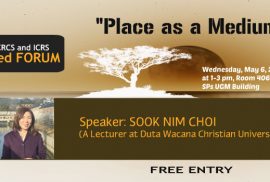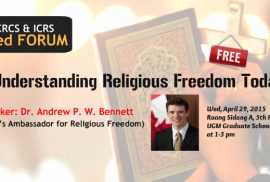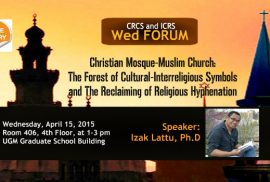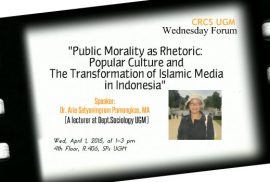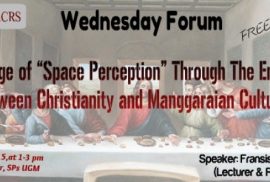
Abstract
During the Jacob’s early journey, when he had reached certain place, he stopped for the night to rest. He took one of stones to rest his head down to sleep. He had a dream which he had an encounter with God and received blessings from him. Next morning he was afraid and said, “How awesome is this place! This is none other than the house of God; this is the gate of heaven.” Then he poured oil on top of the stone that he had used as pillow. He called that place Bethel.
Do we need a physical place to express our belief or to have a relationship with God or gods? For a long history of humanity has been having a special ‘site’ to gather to worship and share their faith with one another or a secret personal place to adore a higher being. During the Forum, I will use a variety example of places globally visiting temples and sites in Indonesia, korea, Germany, and Tunisia, during the 9th century to compare each other cultures and belief. And temples and ‘site’s that they built will be analyzed to understand their differences and their communalities relation to their belief at that time. The research for their relationship between faith and their special ‘site’ can also leads to ask another questions like do we also need a physical place in the same manner as before? Is there any change in our concept in desire for the worship fashion? If there is any change, what or where is the new place can be substituted the old sites?
Speaker:
 SOOK NIM CHOI. Born in Seoul Korea, in her teen years her family emigrated to São Paulo, Brasil. Studied at Instituto de Matematica e Estatistica da Universidade de São Paulo. After marriage she went to the USA and earned a Bachelor of Fine Arts, at the San Francisco Art Institute, CA, and a Master of Fine Arts, concentration in Painting, at the University of California, Berkeley, where she taught Painting and Installation class for undergraduates. She also assisted all levels of teaching as the director of art in Palo Alto Art Studio. She has been an artist and still very actively exhibiting. She is a successful entrepreneur of ‘Pepe Francois’ a fashion design jewelry business in San Francisco and ‘Palo Alto Art Studio’ an art portfolio creating business in Silicon Valley for many years.
SOOK NIM CHOI. Born in Seoul Korea, in her teen years her family emigrated to São Paulo, Brasil. Studied at Instituto de Matematica e Estatistica da Universidade de São Paulo. After marriage she went to the USA and earned a Bachelor of Fine Arts, at the San Francisco Art Institute, CA, and a Master of Fine Arts, concentration in Painting, at the University of California, Berkeley, where she taught Painting and Installation class for undergraduates. She also assisted all levels of teaching as the director of art in Palo Alto Art Studio. She has been an artist and still very actively exhibiting. She is a successful entrepreneur of ‘Pepe Francois’ a fashion design jewelry business in San Francisco and ‘Palo Alto Art Studio’ an art portfolio creating business in Silicon Valley for many years.
Now she is residing in Yogyakarta and works as a lecturer in the Faculty of Architecture dan Design Product in Duta Wacana Christian University. Email: sooknimchoi@gmail.com
Wednesday Forum News

Canada’s Office of Religious Freedom
On February 19, 2013, Canada’s Prime Minister, the Right Honourable Stephen Harper, announced the establishment of the Office of Religious Freedom within Foreign Affairs, Trade and Development Canada. Its mandate is to promote and defend freedom of religion in the world as a key foreign policy priority of the Government of Canada.
In advancing freedom of religion, the Office of Religious Freedom will draw upon the Canadian experience of pluralism that is grounded in Canada’s multicultural and multi-faith society. Promoting and defending freedom of religion is a core element of Canada’s principled foreign policy based on respect for freedom, democracy, human rights and the rule of law.
Abstract:
The paper examines religious shrines as symbols and the cluster of local knowledge of Christian-Muslims relationships in Maluku. In the social-cultural context of Maluku, religious sanctuaries — mosque and church- have become interreligious spheres. Although the shrine stands for a specific religious ritual, in the cultural sense the building is the responsibility of interreligious community who intertwined in shared cultural identity (pela).
This research explores church and mosque as symbols of interreligious hyphenation. It is a hyphenated reality because, in the cultural sense, church-mosque belongs to Christian and Muslim. In the local dynamic of Christian-Muslim engagement, the shrine conveys the collective memory of kinship (rasa orang basudara) among Malukan Muslims and Christians. Using an interdisciplinary approach: Christian-Muslim engagement in the sociology of religion and collective memory in folklore studies, this paper explores Malukan church-mosque as the representation of the total system of indigenous culture in five islands in Maluku.
 Abstract:
Abstract:
For the past two decades, Islam in Indonesia has been at the forefront of the production and consumption of popular culture. Contemporary forms of Islamic pop culture mobilize a sense of nostalgia since Islam was very much marginalized especially during the authoritarian regimes in post-colonial Indonesia. Meanwhile pressures to uphold public morality derive from Da’wa practices underlying the value of ‘amr ma’ruf nahi munkar’ (enjoining good and forbidding wrong) – this phrase becomes a central doctrine for public morality and the key rhetorical struggles promoted by Islamic media including those adopting pop style .
This rediscovery of Islam not only benefits political Islam activities, it induces a greater need to explore new activities in the cultural, aesthetic, legal and intellectual realms to justify and celebrate newly acquired privileges, and to express new identities and aspiration, and to expand politico-economic positions.
Speaker :
 Dr. Arie Setyaningrum Pamungkas, MA is a lecturer and researcher at Dept.Sociology Gadjah Mada University Yogyakarta Indonesia. She obtained BAin Sociology in 1998 from Gadjah Mada University and MA in Sociology and Cultural Studies in 2003 from The University of Sydney, Australia. Her PhD is in Southeast Asian Studies from Humboldt University of Berlin in 2014 on dissertation titled ‘The Dakwah Media in Post Suharto Indonesia: From Politics of Identity to Popular Culture.’
Dr. Arie Setyaningrum Pamungkas, MA is a lecturer and researcher at Dept.Sociology Gadjah Mada University Yogyakarta Indonesia. She obtained BAin Sociology in 1998 from Gadjah Mada University and MA in Sociology and Cultural Studies in 2003 from The University of Sydney, Australia. Her PhD is in Southeast Asian Studies from Humboldt University of Berlin in 2014 on dissertation titled ‘The Dakwah Media in Post Suharto Indonesia: From Politics of Identity to Popular Culture.’
 Abstract
Abstract
This presentation examines the history of the Western imagination about Islam. Throughout history, Muslim men have been depicted as monsters. The portrayal of humans as monsters helps a society delineate who belongs and who, or what, is excluded. Even when symbolic, as in post-9/11 zombie films, Muslim monsters still function to define Muslims as non-human entities. These are not depictions of Muslim men as malevolent human characters, but rather as creatures that occupy the imagination — non-humans that exhibit their wickedness outwardly on the skin. They populate medieval tales, Renaissance paintings, Shakespearean dramas, Gothic horror novels, and Hollywood films. In her book, Muslims in the Western Imagination, Dr. Srjana examines the dehumanizing ways in which Muslim men have been constructed and represented as monsters, and the impact such representations have on perceptions of Muslims today.
 Speaker:
Speaker:
Dr. Sophia Arjana is Visiting Assistant Professor of Islamic Studies at the Iliff School of Theology in Denver, Colorado. She has just published her first book, Muslims in the Western Imagination (Oxford, 2015), a study of imaginary Muslim monsters in the West. Dr. Arjana has also written on race and Orientalism, Jewish and Islamic liberation theology, Islamic pilgrimage, and postcolonial liturgy.She is currently co-authoring a book on female Muslim superheroes in comic books, graphic novels, and television cartoons. Her next major project focuses on pilgrimage traditions outside of hajj and the ritual objects associated with these journeys.

Abstract
The encounter between Christianity and Manggaraian people has transformed a lot of aspects of traditional indigenous life of Manggaraian people. One aspects in which we can see this traditional life of Manggaraian people is through its oral tradition. Here I focus on myth and the related ritual of Manggaraian people.
In this study I want to answer this main research question: Do Manggaraian traditional myths and rituals from the earliest recorded records, still play an important role in the present Manggaraian life? This question will be derived in those following derivative questions. 1. What are the most important myths and rituals and theme in the recorded tradition? 2. Are they still influential? 3. Have they been changed through interaction with catholicism? 4. Has Catholicism in Manggarai been affected by these myths and rituals and practices also? Here I will focus in this discussion on the derivative question number three. And my answer is an affirmative one: There is a change in the space-perception of Manggaraian people due to the encounter with Christianity.
Presenter:
 Fransiskus Borgias. M, Lecturer and Researcher at Philosophy and Theology Department of Catholic University of Parahyangan Bandung. Study philosophy in STF Driyarkara Jakarta (BA). Studied Theology in Major Seminary Sancti Pauli Kentungan Yogyakarta (S1). Study masteral for intercultural theology in Radboud University Nijmegen, Nederland. Ph.D.,Candidate in ICRS Yogya. Write 10 books and translate 8 books. Visiting Researcher at Theology Department of Georgetown University, Washington DC, USA.
Fransiskus Borgias. M, Lecturer and Researcher at Philosophy and Theology Department of Catholic University of Parahyangan Bandung. Study philosophy in STF Driyarkara Jakarta (BA). Studied Theology in Major Seminary Sancti Pauli Kentungan Yogyakarta (S1). Study masteral for intercultural theology in Radboud University Nijmegen, Nederland. Ph.D.,Candidate in ICRS Yogya. Write 10 books and translate 8 books. Visiting Researcher at Theology Department of Georgetown University, Washington DC, USA.

